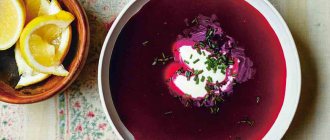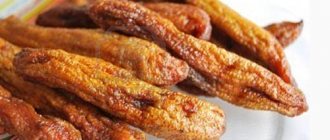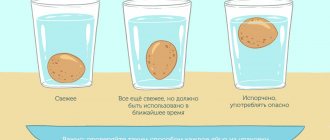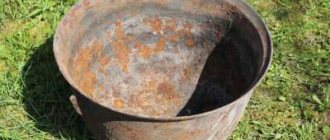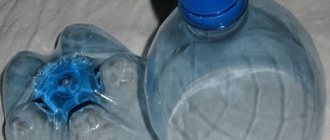v 34 261
Of course, cream can now be bought in any store, but you want to be sure of the quality of the product. In fact, making cream from milk at home is quite simple. We will share with you three ways to make cream from milk at home.
How to make homemade cream from milk - three best ways
How is cream formed?
Cream is a dairy product obtained from milk during the process of skimming it; in other words, it is the fat-containing part of milk. To separate them, always use homemade, full-fat milk. A sufficient indicator is from 4%. The natural product contains no additives that will affect the taste, quantity and quality of the cream. You will not get cream from store-bought homogenized milk.
The most delicious cream is separated using a separator, but not everyone can afford such a purchase.
The resulting product is quite fatty (20-25%, depending on the milk taken), tasty and tender cream. Use them to make desserts, drinks, whip them into butter or make sour cream.
Who is contraindicated for cream?
However, even such an excellent product has some contraindications. Cream is not recommended for children under two years of age. This is still too heavy a product for their body. As for adults, cream should not be consumed by people with obesity or metabolic disorders. They can become taboo in case of hypertension, liver pathologies, heart and vascular problems. The product is especially contraindicated for those who suffer from intolerance to all dairy products. Scientists treated such fatty foods with some caution when people had high cholesterol levels. However, recent studies have shown that the benefits of cream are great. And their effect on the formation of cholesterol plaques is exaggerated.
How to assemble: simple method
To collect the cream, just let the milk sit until a clear border appears on top. A fatty product will be higher.
Collection instructions:
- Pour the milk into a clean container: jar, dish, glass. It is better to take glass containers, through the walls of which the dividing line will be visible.
- Refrigerate the product for at least 12 hours.
- The cream will collect on its own at the top of the dish, the milk will remain at the bottom.
- Using a spoon, carefully separate the cream from the milk. It is better to find an unnecessary device made of thin metal and bend it like a scoop. Or use a small ladle.
- Do not shake the jar to avoid accidentally mixing the two products.
- From the first time, approximately 1/10 of the milk goes into cream.
Advice from Miss Clean magazine: Milk can be re-infused. This time it will take at least a day to get a greasy top layer.
Working with a separator at home
If you have a home separator, then it is wiser to use it. Why does the device sometimes separate cream poorly, and how can I adjust it?
There are several reasons for the incorrect operation of the separator:
- Parts (rubber gaskets, brushes) are worn out.
- You use hot milk (take cold, no higher than 40 degrees).
- Incorrect installation of the creamer.
If the milk is not separated, inspect the structure for wear, clean it, and tighten the milk supply screw. If necessary, replace the O-ring on the rotor.
Cream is very tasty, but do not forget that you need to control the amount of fatty product in your diet.
Delicate buttercream gives even the simplest cake delicate sophistication and incredible taste. That is why cream is one of the main ingredients of all kinds of desserts and baked goods. But not every housewife manages to turn cream into an airy mass. But how to whip cream correctly so that the cake turns out great and the celebration is not ruined? It turns out that you just need to choose the cream well and stick to a few tricks while whipping it.
Cream is a delicious dairy product that is made by separating the fat fraction from whole milk. Cream is supplied to the retail chain in pasteurized form with a fat content of 10 to 35%. Due to its nutritional value, cream is recommended for daily and dietary nutrition. Among the chemical components in the cream, in addition to milk fat, there are enough proteins, mineral elements, as well as vitamins A, D, C, PP, etc.
Cream is suitable for making butter, sauces, dressings, and a variety of culinary products. Heavy cream whips well into a stable porous foam, so it is used as a base for preparing confectionery dishes.
What is dairy processing based on?
Fresh cow's milk is a suspension in which fat globules, called cream, are mixed with the heavier molecules of the rest of the milk. They are easily separated from the bulk of the product by floating. To speed up the separation of fractions, milk separators have been created. Subsequently, the heavy residue is separated into curd mass and whey, but this is after ripening. There are also separators to separate them.
If the final result of processing is 1:10, it means that for every 10 liters of skim milk, 1 liter of cream is obtained from 11 liters of milk. This is cream containing a large amount of butter and little liquid fraction. But you can get 3 liters of cream for 8 liters of skim milk. Such cream will be liquid and little butter will be obtained from it. The separator allows you to create a ratio from 1:4 to 1:12.
In everyday life and for the primary processing of milk, small farms use only cream separators or separators, which is the same thing. Cream separation occurs under the influence of centrifugal force, which throws heavy particles to the periphery, while light particles remain closer to the center. After separation, all that remains is to select the fractions into separate containers.
The milk separator is a customized system for the continuous supply of milk into a rotating disc drum and the selection of cream and skimmed milk, or skim milk.
How to choose the right whipping cream
On store shelves you can buy different types of cream: dry, fresh, canned, full-fat or low-fat. All of them are used in the kitchen for different purposes. But, to prepare the cream, you need to choose cream that will whip well. To make the right choice, you need to consider the following points:
- The packaging of cream must indicate a fat content of at least 30%. The higher the mass fraction of milk fat, the thicker the cream is whipped. Less fatty cream is also suitable for cream, but its consistency retains the desired appearance much less well.
- Only natural milk fat whips well. When purchasing, study the composition; it should not contain thickeners, stabilizers, palm oil or other additives.
- Don't forget to look at the production date. Only fresh cream whips well. A product that has already stood for several days may separate when whipped.
- Consider the storage conditions for cream in the store. They should be laid out on the shelves of the refrigeration unit, and not in the freezer.
To choose high-quality cream, you will have to go through a lot of trial and error. Test products from different manufacturers and choose the best option.
Important!
You can buy ready-made whipped cream in the store, but this product contains a number of harmful additives and preservatives, so consuming it is extremely undesirable.
What is it and what is it for?
Milk separation is an important stage of processing, during which the milk is separated into cream and a skim part (skim). This process not only extends the shelf life, allows you to obtain different types of fermented milk foods, but also contributes to the mechanical purification of this natural product from various impurities.
For what reasons may cream not whip?
Very often, housewives who whip cream for the first time are faced with a very unpleasant surprise. Instead of an airy creamy mass, they get a two-phase mixture based on whey and oil. Most people immediately get upset when they think about their poor knowledge of cooking, but even the most professional chefs are not immune from this outcome. The main culprits for such culinary failures are considered to be the following:
- The cream was not fat enough.
- The cream was not pre-chilled.
- Sugar was added prematurely.
- Incorrect attachments selected.
- The cream turned out to be counterfeit with impurities of vegetable oils.
Interesting!
The nutritional value of cream lies in the fact that it is rich in phospholipids, which prevent the development of atherosclerosis.
Factors influencing the process
There are several factors that affect the quality of separation:
- Liquid density. The higher it is, the lower the quality of the resulting product. The degree of thickness can be reduced by heating the milk.
- Fat content of milk. The larger it is, the slower the separation process occurs. In order to increase its speed, it is necessary to increase the number of cleaning plates that are located in the device itself.
- Incorrect technical processes. They also affect the separation rate, slowing it down. This happens because rough pumps deform fat particles during industrial pumping of milk. When the particles are round in shape and large in size, separation occurs much faster.
The temperature of the initial product is the main criterion that affects the quality of the final result. The optimal mode for household separators is 35-45°C.
Important Factors
If you want quality product processing, you need to pay attention to the factors influencing milk separation. These include the following:
- High quality raw materials. The fact is that without good milk, even the most expensive separator is not able to work a miracle. Here it is necessary not to overdo it with fat content, and its optimal content is considered to be 3%. It is also necessary to monitor temperature and acidity. Slightly warmed milk will be much easier to process. It is first necessary to clean the product from wool and other particles, especially if goat milk is separated.
- Correct operation. Use the separator only in accordance with the attached instructions. It is very important to properly care for the device, clean and rinse all parts after each separation process. Before starting work, you must carefully study the separator diagram; it is advisable to assemble it by studying the instructions. Before pouring raw materials into the receiver, you need to carry out one cycle with plain warm water. Thanks to this, all remnants of detergents after the last use are washed off or the top layer of dust is removed from the device.
It is important to note that all parts in the separator must fit tightly together, without gaps. For the greatest confidence in your own abilities, you can turn to professionals or watch special video tutorials.
As you can see, the separation process at home is not so difficult. To do this, you just need to purchase the simplest separator.
Selection of equipment and preparation of cream
If you get your hands on a package of cream for the first time, you are probably wondering what to use to whip it. Experienced confectioners assure that this product can be whipped using various kitchen appliances with adjustable speed settings. The only thing you should not use is standard blade attachments on a mixer or blender. They will help you turn the cream into butter and liquid. The best option is to use a hand blender and mixer so that you can control the intensity of whipping the cream.
So, the cream has been selected, the equipment has been prepared, now you need to prepare everything for making the buttercream. The most key points:
- The cream needs to be cooled to +5..+7⁰С. To do this, you can put them in the refrigerator for 2-3 hours. Under no circumstances should you put cream in the freezer compartment; after defrosting, you will end up with sour milk and flakes.
- Experienced cooks advise cooling dishes and equipment parts that will come into contact with cream. To create favorable conditions, you can also put the bowl and attachments in the refrigerator for several hours.
- For buttercream, it is better to use powdered sugar instead of sugar. It should be sifted using a sieve so that there are no lumps in the cream.
How to skim milk at home?
How to skim milk by settling
- Fresh milk
should be poured into a saucepan or large bowl (this will make skimming the cream easier). - Place the container in the refrigerator overnight. In 10–12 hours, the cream will separate from the milk mixture naturally.
- Take a clean spoon and carefully skim off all the cream. They are suitable for consumption.
Interesting materials:
Where can I see the battery status on my iPhone? Where can I see iPhone charging cycles? Where can I see all iPhone backups? Where can I see my order for Wildberries? Where was alcohol invented? Where is big data analysis used? Where is C++ used? Where are illustrative graphics used? Where is baking soda used? Where is Direct Acting Automatic Brake used?
Whipping cream: cooking secrets
When the cream is ready for whipping, you can proceed to the cream preparation stage:
- Pour the cream into a whipping container. This can be a blender or food processor bowl, or any bowl with high edges. If the bowl is not very high and has a wide bottom, the beaters will not be able to completely immerse themselves in the creamy mass and beat it well. If you can’t use another bowl, just tilt it a little at an angle while whipping so that the cream acquires a uniform structure.
- Mix the cream thoroughly so that the fat is evenly distributed throughout the volume. If you need to whip a large portion of cream, it is better to do it in several approaches. The optimal portion is no more than 300 mg.
- High whipping speeds are not suitable for cream, as such intensity will instantly cook the butter. You need to start beating at low speed and slowly switch to medium.
- The duration of whipping cream depends on various factors. The freshness of the product, its thickness, cooling temperature and the type of attachments used play a role here. But, on average, it takes 5-7 minutes to prepare whipped cream.
- You can determine readiness by the type of cream: if the traces from the whisk have stopped spreading, it means the cream has already been whipped.
- Now the main thing is not to overdo it, so that instead of cream you end up with butter. Slowly reduce the speed and turn off the mixer.
Interesting!
There is a guess among historians that whipping cream was first invented by François Vatelem, who served as head waiter in a castle on the territory of the commune of Chantilly around the middle of the 17th century.
- If you are preparing a sweet cream, start adding powdered sugar in a thin stream 1.5-2 minutes after the start of whipping. If you add powder at the initial stage, the cream may become liquid, and if you add the entire portion of powder at once, lumps will appear in the cream.
- If you need to prepare a very thick cream for a cake, you can add a special starch-based thickener to the cream.
- If the whipping process does not go as planned and the cream does not whip at all, you can try adding the juice of ¼ lemon.
- You can thicken the buttercream using edible gelatin or agar-agar. To do this, prepare gelatin according to the instructions and add to the cream. Approximate proportion for preparing cream: ½ tbsp. l. gelatin per 250 ml cream.
On a note!
The shelf life of whipped cream is 24 hours in the refrigerator.
In fact, there is nothing difficult in the technology of whipping cream, the main thing is to buy high-quality cream and follow the recommendations of experienced confectioners. Experiment, discover new recipes and let your buttercream always turn out tender and tasty.
Few people know how to make whipped cream correctly so that it turns out tender and airy. This product is often used to make various desserts and baked goods, and almost everyone has tried it.
And in stores you can find ready-made whipped cream in cans, but they are not always of the proper quality, so it is better to learn how to make this delicacy yourself. The process of its preparation has many subtleties and nuances, which will be discussed in today’s article.
To know how to whip cream correctly, pay attention to some recommendations before you start:
- The calorie content of the dish ranges from 160-335 kcal per 100 g. This “range” directly depends on the fat content of the original ingredient. To reduce the number, you can add a little milk;
- You need to choose only the best, freshest and highest quality cream. The most suitable option is a classic product with a fat content of 33 percent. Whipping will occur perfectly, into a strong foam. Low-fat dairy products (10 percent) or medium-fat (20 percent) are also suitable, but they will whip very poorly and will not turn out airy. In this situation, you will have to use gelatin or egg whites for thickening;
- The cream must be slightly cooled, but not frozen or warm, otherwise it will separate into butter and whey;
- The whisk and bowl also need to be placed in the freezer for a short time. Use metal kitchen utensils for cooking;
- To prevent the container from heating up during operation, keep it in ice water;
- Do not beat the entire portion of the product at once, but divide it into 200-300 ml parts;
- Do not immediately set the mixer to high speeds, but increase them gradually;
- The shelf life of the finished product in the refrigerator is no more than 12 hours.
Recipe 6. Mushroom soup with cream
Ingredients
- 200 g frozen wild mushrooms;
- crackers;
- 1 l 200 ml chicken broth;
- greenery;
- 200 g potatoes;
- vegetable oil;
- bulb;
- 100 ml homemade cream;
- carrot;
- garlic - two cloves.
Cooking method
- Peel and wash the vegetables. Finely chop the onion, finely grate the carrots. Finely chop the garlic. Place all vegetables in a frying pan with heated oil and sauté until soft.
- Thaw the mushrooms and fry separately until the liquid evaporates.
- Finely grate one potato and chop the rest into small cubes.
- Place potatoes in a saucepan with chicken broth and boil until soft. Then add the fried vegetables and pieces of boiled chicken. Add some salt.
- Pour cream into boiling soup and remove from heat. Serve by pouring into bowls and adding croutons to each piece.
Whip cream with a mixer
This is the easiest and fastest way to make your favorite sweet dessert.
You will need:
- Granulated sugar – 50 g;
- Cream 33% - half a liter;
- Egg or gelatin for fixing (optional).
How to whip heavy cream with a mixer:
- Pour the dairy product into a deep metal container, wrap it in cling film and place it in the refrigerator for 50 minutes. Place the whisk attachments in the cold for the same time;
- Grind the sugar into powder in a coffee grinder and additionally pass it through a sieve with a fine sieve to get rid of large particles;
- We remove the dishes and tools from the refrigeration chamber, remove the film and begin beating in a circular motion, setting the device to minimum speed, then gradually increasing the speed;
- After about 7 minutes, the mass will begin to become thick. We begin to gradually add powdered sugar - it will help whip the cream into foam and give it a pleasant sweetish taste;
- Continue the process for another 5-6 minutes until stable peaks are obtained. Do not exceed the specified time, otherwise oil will form;
- To obtain a thick consistency, you can optionally add lemon juice, gelatin or an egg as a fixative. They should be included at the very end of cooking.
Place the prepared whipped cream with powdered sugar into bowls and refrigerate, otherwise they will quickly “float” at room temperature.
Problems using the device
Each device has an instruction manual that must be carefully studied and followed. A possible cause of problems may be design features that were not taken into account during assembly. Some problems can be summarized and basic recommendations for correction can be given. However, you should always rely on the model used and information from the manufacturer.
The separated product does not thicken
- The reason may be excessively hot milk, in which case it needs to be cooled to the temperature of fresh milk, about 40 degrees.
- You also need to get rid of dirt from the drum. It should be disassembled, cleaned and rinsed from sediment.
- It would be a good idea to check the position of the adjusting screw. If it is screwed in too much, you need to turn it 1-1.5 turns.
- Thickness will appear after prolonged exposure to the cold. In cases where waiting time is limited, you can use a mixer. The main thing is not to overdo it and make butter.
Why does he drive so fat?
First of all, you need to try changing the position of the regulator. It can also be caused by milk that is too cold. The optimal temperature of the raw material is 35-45 C. The tap is not fully open. The float is not in place.
For what reason does it not separate from milk or does it poorly?
The most common reasons are:
Whip the cream by hand with a whisk
Many chefs claim that this method is the best, because the product prepared in this way is stable and fluffy due to the large amount of oxygen.
List of ingredients:
- Powdered sugar – 30 g;
- Heavy cream (33-35%) – 350 ml;
- Vanilla sugar – 10 gram bag;
- Lemon juice - half a teaspoon.
Homemade whipped cream recipe with photo:
- We prepare a comfortable metal bowl with a wide top so that it is convenient to make intensive movements with a whisk. Cool the tool and the main component according to the same instructions as in the previous recipe;
- Next, place the bowl in a container with ice or ice water and hold it at a slight angle. This will help the contents circulate better, and therefore a stable consistency will form faster;
- Slowly we begin to make circular movements with the whisk and gradually accelerate. When the mass becomes thick, combine it with vanilla-based sugar and powder, mixing them in small portions;
- Continue beating, covering the entire surface of the mixture and stirring it to the bottom of the container.
The milk dish will be ready when the characteristic relief pattern from the whisk begins to remain on the surface. The main thing is not to miss this moment and not to overdo it, otherwise you won’t be able to whip the thick cream, and it will simply settle. At the end of the process, you need to pour in lemon juice, which acts as a consistency stabilizer.
Recipe 5. Cod with cream sauce
Ingredients
- half a kilogram of cod fillet;
- black pepper;
- 200 ml homemade cream;
- salt;
- four cloves of garlic;
- 200 g flour;
- 30 g butter.
Cooking method
- Defrost the cod fillet and cut it into pieces eight centimeters long. We check it for the presence of seeds. If there are any, carefully remove them with tweezers.
- Pour vegetable oil into the frying pan. Put it on the fire and add the chopped clove of garlic.
- Dredge the fish in flour and fry on both sides until golden brown.
- Grind the rest of the garlic together with the washed herbs. Heat the cream in a saucepan. Add flour. Stirring constantly to avoid lumps. Add garlic and herbs, salt. Stir and bring the mixture to a boil.
- Place the finished cod on a plate, pour in the sauce and sprinkle with chopped herbs.
Whip dry cream
- Place 5 large spoons of this product in a glass, into which we then pour water;
- Mix everything thoroughly;
- Add a glass of milk to the mass with an amount of 150 ml, and mix all the ingredients until smooth;
- We put the finished mixture in the refrigerator, and put it in the freezer two minutes before whipping.
Prepare the cream using a mixer or whisk, first at low speed, which we gradually increase. After thickening, it must be reduced. We will definitely place the finished product in the refrigerator.
This dry whipped cream is suitable for making desserts, cakes and pastries.
Recipe 4. Chicken gizzards stewed in cream
Ingredients
- 700 g chicken stomachs;
- pepper mixture;
- 150 ml homemade cream;
- salt;
- two onions;
- clove of garlic;
- carrot;
- 50 ml vegetable oil;
- Bay leaf;
- 30 g flour;
- two peppercorns.
Cooking method
- We wash the chicken gizzards and boil them until tender, salting the water and adding peppercorns and bay leaves to it. Cooking for one and a half hours.
- Then drain the broth, cool the ventricles and cut them into small pieces.
- Chop the peeled onion into half rings and fry until transparent.
- Peel the carrots and roughly chop them. Add it to the onion, stir and cook for a couple more minutes.
- Place the gizzards on top of the vegetables. Pour in the cream and add flour.
- Stir and season with salt and spices.
- Simmer, covered, for 20 minutes.
- Three minutes before readiness, add finely chopped garlic.
Cream dessert with fruits
Required components:
- Mandarin, banana, kiwi;
- 2/3 cup cream;
- A pinch of vanillin;
- 0.5 cups of powder.
How to make whipped cream with fruit:
- The first step is to prepare the fruit - cut them into small slices or grind them using a blender. There is no need to mix them together;
- We whip using one of the methods indicated above, and we will begin to form our delicacy;
- Place the banana slices on the bottom of a beautiful glass form and cover it with butter cream;
- Next, make a row of kiwis, add the creamy mixture again;
- The last layer is tangerines, which we will also cover with the creamy mixture, sprinkle with chocolate chips and set aside to cool.
Chocolate buttercream for cake
Chocolate whipped cream for a cake can act as an independent dessert, and can also be used to decorate many other delicacies.
Components:
- 30 g cocoa powder or 50 g chocolate;
- 2 cups cream (fat content – 20%);
- A small spoon of gelatin;
- 1/3 cup powdered sugar.
Step by step action plan:
- Take 1/3 of the given amount of cream and pour the gelatin over it. After it swells, place the dishes with the contents in a container of water, which we heat until the gelatin dissolves, remembering to stir;
- Remove the container from the stove and let the contents cool;
- Take another 1/3 of the mass of the main ingredient, heat it until hot and thoroughly dissolve the cocoa powder in it. If you decide to use chocolate, melt it first. Then it will mix easily;
- Next, combine the creamy remains with the powder and begin to beat slowly. When the first foam appears, pour in delicious chocolate cream, and after some time add gelatin.
Recipe 3. Fettuccine with seafood in creamy sauce
Ingredients
- 400 g fettuccine;
- paprika;
- 450 g shrimp;
- fresh herbs;
- 5 ml vegetable oil;
- black pepper;
- bulb;
- salt;
- 10 g butter;
- 50 g cheese;
- clove of garlic;
- two glasses of homemade cream;
- 100 ml dry white wine.
Cooking method
- Boil the fettuccine until tender, following the instructions on the package. Defrost the shrimp, if necessary, clean and dry. Place on a plate, season with pepper, paprika, salt and other spices.
- Fry the shrimp on both sides in a frying pan with a minimum amount of vegetable oil.
- We transfer the shrimp to a plate, and put finely chopped onion in the frying pan and squeeze the garlic through a press. Fry for just a couple of minutes and pour in the wine. Stir with a spatula and keep on high heat for three minutes.
- Now pour the cream into the pan, stir and simmer for another two minutes. Add finely grated cheese to the hot sauce, salt, pepper and a pinch of paprika. Mix.
- Add fettuccine and shrimp to the sauce. Mix carefully and keep on fire for just another minute. Serve with a pinch of finely chopped fresh herbs.
Video: 3 options for whipped cream
How to make cottage cheese from milk at home
Market homemade cottage cheese, as a rule, contains a significant amount of liquid, which enterprising sellers do not squeeze out completely and leave it to gain weight. Whey gives the cottage cheese a slightly different taste, and excess moisture significantly shortens its shelf life. If you prepare a dairy product yourself, then you can choose the taste, fat content, and moisture content at your discretion, depending on the purpose for which it is being prepared.
Cream from milk
The first way to make homemade cream is the simplest.
Take fresh cow's milk and place it in a cool place. After about one day, the milk will settle, and a layer of cream will form on top of it. Carefully pour it off so that the cream does not mix with the milk. To do this, you can use special spoons - creamers.
Design and principle of operation of the separator
All separators can be divided into:
- production;
- for the household.
Industrial units are large in size. They allow processing up to several tons per day.
Household devices are widely used in private households. They are simpler in design and operation. The devices do not require time and effort for maintenance.
Separators designed for farmers can process up to 10-20 liters per day.
Types of devices by purpose:
- cream separators split the whole product into fatty and low-fat;
- normalizers are used to produce normalized milk;
- cleaners remove dirt and foreign matter;
- universal separators perform several functions;
- curd units separate the curd and whey;
- classifiers clarify milk.
There are devices that clarify and degrease whey.
Various types of units are often used in dairy production. In households, a universal household device is more often used.
The design of the devices is:
- open;
- semi-closed;
- closed.
Open devices are simple and can be portable or stationary. The disadvantage of the devices is that due to contact with oxygen, milk foams, and this reduces productivity.
In semi-closed units, the drink still has contact with air, but the processed products are redirected into containers through sealed tubes. The advantage of the devices is the sterility of the supplied substances.
Closed devices are complex, they are often used for industrial purposes. Without them, it is impossible to launch a line where raw materials will be processed.
The pipelines of the devices are completely sealed, there is no air access to the original product. The processed substances are obtained absolutely clean, without mixtures of odors.
The drive type of household separators is:
- manual;
- electric.
Devices with electrical equipment are the most convenient to use and more productive. Manually operated devices are independent from electrical networks and are affordable.
A manual or electric milk separator separates the original product into fat and skim milk due to the rapid rotation of the drum. In this case, the liquid is in a bowl of a convenient size, and it is acted upon by attractive forces, which contribute to the concentration of the liquid near the walls.
Fat globules are light, and therefore, when moving, they tend to its axis. If the rotation is fast enough, it takes very little time to split.
In this case, a stream of white liquid appears, which is called skim milk, and a yellowish thick stream is cream. The drum rotation speed is 10-15 thousand revolutions per minute. Further mixing of separated products is eliminated thanks to special outlets.
They are arranged in a distribution area at the top of the drum called trays. Cone-shaped parts with perforations are located around the circumference with small spikes. They are usually laid out in a pyramid, forming a package in which the splitting occurs.
There is a special cavity in the drum for dirt. The entire structure represents the upper part of the separator. The supply of milk to the drum is dosed, due to a special float chamber. The bowl of the production separator itself is of decent volume. In household designs, the container size is about 5-7 liters.
The electrical part of the device is located at the bottom. All control elements are located on the housing with the electric motor. Manual separators are equipped with a removable handle.
The operating principle of manual and electric milk separators is similar. The design of both types of devices is collapsible. This is necessary for thorough washing of all parts.
What is a milk separator and why is it needed?
A milk separator is a device that allows you to separate milk from impurities or separate milk fractions. It can have different sizes and performance. Their prices also vary.
In any dairy farm, sooner or later the need arises for milk processing. A cow usually produces between ten and twenty-five liters per day during the cow's milking period. Naturally, this is too much for the needs of one small family, and the question arises: in addition to milk, you want to receive additional products in the form of cheese, butter, sour cream and other products.
The easiest way to make sour cream and butter is using cream. And let low-fat milk go on sale. In addition, the practical nutritional value for the body of milk from which the cream has been skimmed and milk that is in its original form is almost no different. This allows you to eat low-fat milk, and make butter and sour cream from cream. The separator is used to separate the cream. This is especially true due to the lack of normal butter on sale at all - real butter has become a scarce and dietary product, which can be obtained in any farm where there is a cow, having a special separator.
If there is more than one cow on the farm, then another problem arises - milk purification. When milking, a large number of milk clots enter the milk pan, since a cow is a living creature, and there may be various undesirable phenomena in its physiology, even if they are not associated with a violation of the health of the animal. In small volumes, the problem is solved by filtering through a cloth.
In large volumes, it is necessary to use a special separator to purify milk, which separates denser clots and solid particles.
Types of separators
There are two main types of separators - a regular one, which is designed to separate milk plasma, and a cream separator. The latter always works after clearing milk from clots, since it has thinner passages that are easily clogged with clots. Therefore, in a farm where oil production is planned, it is advisable to have two separators - a regular one and a cream separator.
Industrial separator-churn
Quite often, the cream separator is combined with another useful device - a butter churn. You can buy separators on sale that, while separating the cream, immediately churn it, making good, high-quality butter without the addition of vegetable fats and harmful ingredients.
Separators can also be divided according to performance and purpose:
- The household milk separator is designed for small volumes of work, has not very high productivity and a reduced service life. Among these devices, usually the majority are manually operated.
- A powerful separator for large farms and dairies must have an electric drive, the ability to fine-tune depending on the fat content of the milk, the ability to quickly and quickly clean it from contaminants, and is designed for continuous operation for several hours.
Electric milk separator
Models of separators with an electric motor are considered productive and powerful, and working with them is a pleasure. The only disadvantage of such units can be considered the necessary availability of power supply, which is not always possible to provide in hard-to-reach places. This type of milk separator is capable of preparing cream in a short time, but its cost is higher than that of manual analogues. The performance of home electric models can vary from 55 to 100 liters; manufacturers pay special attention to the safety of the devices.
Manual milk separator
Mechanical devices for separating milk into components are durable, they rarely fail and can be passed on from generation to generation. The home manual milk separator is made of materials that are resistant to corrosion. The power of mechanical units can process up to 80 liters of liquid in 60 minutes. Manual models are equipped with special fastening systems, which are necessary for stable fastening of the separator to the table.
How to choose equipment?
- If you have several cows/goats and you decide to open a small business producing fermented milk products, then a machine with a capacity of at least 100 l/hour is suitable for you. For example, “Motor SICH SCM-100-19” or “Falcon MS 100 metal”.
- If you are a novice farmer or are going to use the device at home, then the best option for you would be a device with a capacity of 80 l/hour. For example, “Farmer ES-01 80 liters” or “Penzmash Salyut ESB02-04 80 liters”.
- If you want to make cream or butter during your summer holiday in the country, i.e. If you do not do this regularly, but seasonally, then a separator of 50 l/hour will be enough for you. Such as “Ural M” and “Hydrounit Beryozka”.
- If you are counting on a full-fledged farm, choose equipment with a productivity of 500 l/h. Such as "Motor SICH 500".
Attention!
The separator should be installed on the edge of a flat surface in a heated room.
The best separator models
Household milk separators come in a variety of options. Types of separators differ in displacement volume, functions and other qualities. The best options popular among farmers are presented below.
Photo of separator R3-OPS
- “Motor Sich 100” is an electrical device weighing 4-6 kg. Consumes 60 watts. The bowls have a volume of 12 liters. Productivity – 80-100 l/hour. The cost is in the range of 3700-5400 rubles. The price depends on the case material (metal or plastic).
- The separator “Salyut ESB04” is an electric device, small in size. Separates milk from cream while simultaneously filtering it from contaminants. There is an overload protection system. Productivity – 50 l/hour. Cost – 4260 rubles.
- The Farmer separator can process up to 80 liters of milk. The weight of the structure is about 3 kg. Energy consumption – 80 Watt. The cost is within 3900 rubles.
- "Rotor" (Altai) runs on electricity. Power used – 100 Watt. Approximately 55 liters of liquid are processed per hour. Milk receiver with a capacity of 5.5 liters. The weight of the device is 3.5 liters. Price – 2250 rubles.
- The Neptune separator operates from the mains. Productivity – 50 l/hour. It has a stable rotation speed, and the milk fat content can be adjusted with a special regulator. The weight of the device is only 3.2 kg. Cost – 2950 rubles.
- “R3-OPS” (Penzmash) is a manual separator for cleaning or separating milk into fractions. Made from high quality plastic. Productivity – 50 l/hour. The capacity of the milk receiver bowl is 5.5 liters. Cost up to 3000 rubles.
A milk separator can greatly facilitate the work of the milkman. Such a machine is capable of making high-quality cream from fresh milk, butter, and some machines also separate whey from cottage cheese. For large and small farms they are very convenient and profitable to use.
Comparison table of characteristics
In the table below we once again list the main characteristics of the presented devices. By comparing them with each other, it will become easier for you to make a choice in favor of a device that fully meets your wishes and requirements.
| Separator name | Bowl height, mm | Diameter, mm | Dishes |
| HYDRAULIC UNIT SCM-80 No. 18 | 530 | 365 | 11 |
| ROTOR | 330 | 280 | 8 |
| HYDRAULIC UNIT BEREZKA | 310 | 650 | 10 |
| MOTOR SICH-100-18 | 300 | 520 | 12 |
| OM-3 | 280 | 500 | 5 |
| NEPTUNE | 290 | 335 | 8 |
| FARMER ES-2 | 290 | 335 | 12 |
Cream from butter
Alternatively, you can make cream using store-bought milk and butter. The main thing is that these products are fresh and of high quality. You will also need paper napkins and gauze. They can be purchased at the pharmacy.
- Take a medium sized saucepan. Carefully pour all the milk into it and add the butter, after cutting it into small pieces. Then place the pan with all the contents on low heat. Constantly stir the composition of your future cream. It is not necessary to bring the mixture to a boil. It just needs to melt well. Pour a homogeneous warm liquid into a prepared blender and beat it for 5-9 minutes.
To prevent the mixture from turning into oil, turn the blender on at the lowest power first. And only then gradually increase its speed. Turning off the blender should also be gradual.
The fat content of the cream can be changed in any direction, increasing or decreasing the amount of butter. However, pay attention to the fat content indicated on the packaging. It is not difficult to calculate the fat content of cream. Let's say you need 38% cream. This means that 1 kg of product should contain 380 g of fat.
For example, you have 2.5% milk and 80% fat butter. Since it is mainly the butter that gives the cream its fat content, you should focus on it. From 450 g of butter you will get 360 g of fat, and from 550 ml of milk you will get the missing 20 g. There will be an error, of course, but it will be insignificant.
Recipe 1. Dor blue sauce with cream
Ingredients
- 100 g dor blue cheese;
- salt;
- 200 ml homemade cream;
- Provencal herbs.
Cooking method
- Cut the cheese into small pieces and place in a saucepan. Place it on low heat.
- Pour half the cream into the saucepan and cook, mashing the cheese into the cream until you get a homogeneous mass without lumps.
- Gradually pour in the remaining cream, stirring constantly to prevent it from curdling.
- Heat the mixture until the cheese is completely dissolved, but do not boil! Finally add Provençal herbs and salt.
- Pour the prepared sauce into a special form and serve with meat or fish dishes.
Sour cream
Cream can also be made from sour cream at home. They will be thicker and fattier. To do this, pour fresh milk into a glass jar and let it brew. After some time, the cream will rise to the top, and you will notice a delicate “cap” on top of the jar.
The fattier the milk you use to make cream, the thicker this “cap” will be. Carefully remove this kind of “headdress” with a spoon and transfer it to another clean container.
As you can see, it’s quite possible to prepare tasty and healthy foods yourself, even in urban conditions. All you need is desire and patience.
Store-bought cream is not the best and, of course, the most delicious and high-quality product is the one you make yourself. You can make them at home, for this you will need high-quality homemade milk. It is quite fatty and contains no artificial additives. You can prepare cream even without a separator, and you don’t need any special skills for the procedure.
How to separate cream from milk at home
They are distinguished by their low fat content (20-25%) and naturalness. This cream can be used to make desserts, baked goods and creams. The fat content of the cream depends on the fat content of the milk you use.
Helpful tip: Do not use store-bought milk as it has been processed (homogenized) so cream will not form on the surface. You need to use homemade fresh milk.
Check out our post How to Make Cream at Home
Of course, the most delicious and high-quality cream is those that are separated by a separator. But alas, the price for this device is very high, so only large production facilities can buy it.
Method number 1:
take homemade milk and pour it into a plate. Keep in mind that the container must be wide and flat; a deep plate will not work. Place it in a cool place for at least 12 hours, optimally for 20-24 hours. The cream will collect at the top, but the milk will collect at the bottom. Using a spoon, remove the top and store in a glass jar with a lid in the refrigerator.
How can you separate cream from milk? Many people use milk to collect cream just once. We recommend that you let it stand again. After you have collected the top layer for the first time, place the same container in a cool place again, only this time for 1-2 days. You will see that a dense fatty layer has formed on the surface again, remove it.
Method number 2:
thanks to it you will get heavy cream. In addition to milk (500 ml of medium fat content), you will need 250 grams of butter. Pour the milk into a small saucepan and add finely chopped butter. Place over low heat and heat until the butter dissolves. It is important that the liquid does not start to boil. Remove the mixture and beat with a mixer or blender for 2 minutes. Pour it into a container and wait for it to cool. Cover the container with a lid and place it in the refrigerator. Homemade heavy cream is ready!
If the cream prepared according to this recipe seems too fatty to you, reduce the amount of butter used by half. But keep in mind that they will be liquid and can hardly be used to prepare a thick cream.
I would like to warn you right away that there will be very little cream collected in this way - only 1/10 of the volume of milk. But if you want to make a homemade product, why not? We would also like to note that this product has low fat content, so if you are going to make a cream from it, do not forget to add a thickener to it, otherwise it will become watery.
Housewives note that you can make delicious and low-fat ice cream from this homemade product. It can also be added to dough or drinks.
Kaymak
Cream as thick as cheese with an unusual taste is a favorite delicacy of the peoples of the Caucasus. They are called kaymak. And baked milk is used to prepare it.
Fresh milk in a clay vessel must be placed in the oven, preheated to 180 °C and brought to a boil, then reduce the heat to 100 degrees. When a caramel-golden crust forms on the milk, the product should be covered with a lid and left to cool for a day in a dark place. After this time, the brownish foam can be removed with a knife and rolled into rolls. One plate of kaymak is made from 4 liters of full-fat milk.
Few people know how to make whipped cream correctly so that it turns out tender and airy. This product is often used to make various desserts and baked goods, and almost everyone has tried it.
And in stores you can find ready-made whipped cream in cans, but they are not always of the proper quality, so it is better to learn how to make this delicacy yourself. The process of its preparation has many subtleties and nuances, which will be discussed in today’s article.
To know how to whip cream correctly, pay attention to some recommendations before you start:
- The calorie content of the dish ranges from 160-335 kcal per 100 g. This “range” directly depends on the fat content of the original ingredient. To reduce the number, you can add a little milk;
- You need to choose only the best, freshest and highest quality cream. The most suitable option is a classic product with a fat content of 33 percent. Whipping will occur perfectly, into a strong foam. Low-fat dairy products (10 percent) or medium-fat (20 percent) are also suitable, but they will whip very poorly and will not turn out airy. In this situation, you will have to use gelatin or egg whites for thickening;
- The cream must be slightly cooled, but not frozen or warm, otherwise it will separate into butter and whey;
- The whisk and bowl also need to be placed in the freezer for a short time. Use metal kitchen utensils for cooking;
- To prevent the container from heating up during operation, keep it in ice water;
- Do not beat the entire portion of the product at once, but divide it into 200-300 ml parts;
- Do not immediately set the mixer to high speeds, but increase them gradually;
- The shelf life of the finished product in the refrigerator is no more than 12 hours.
